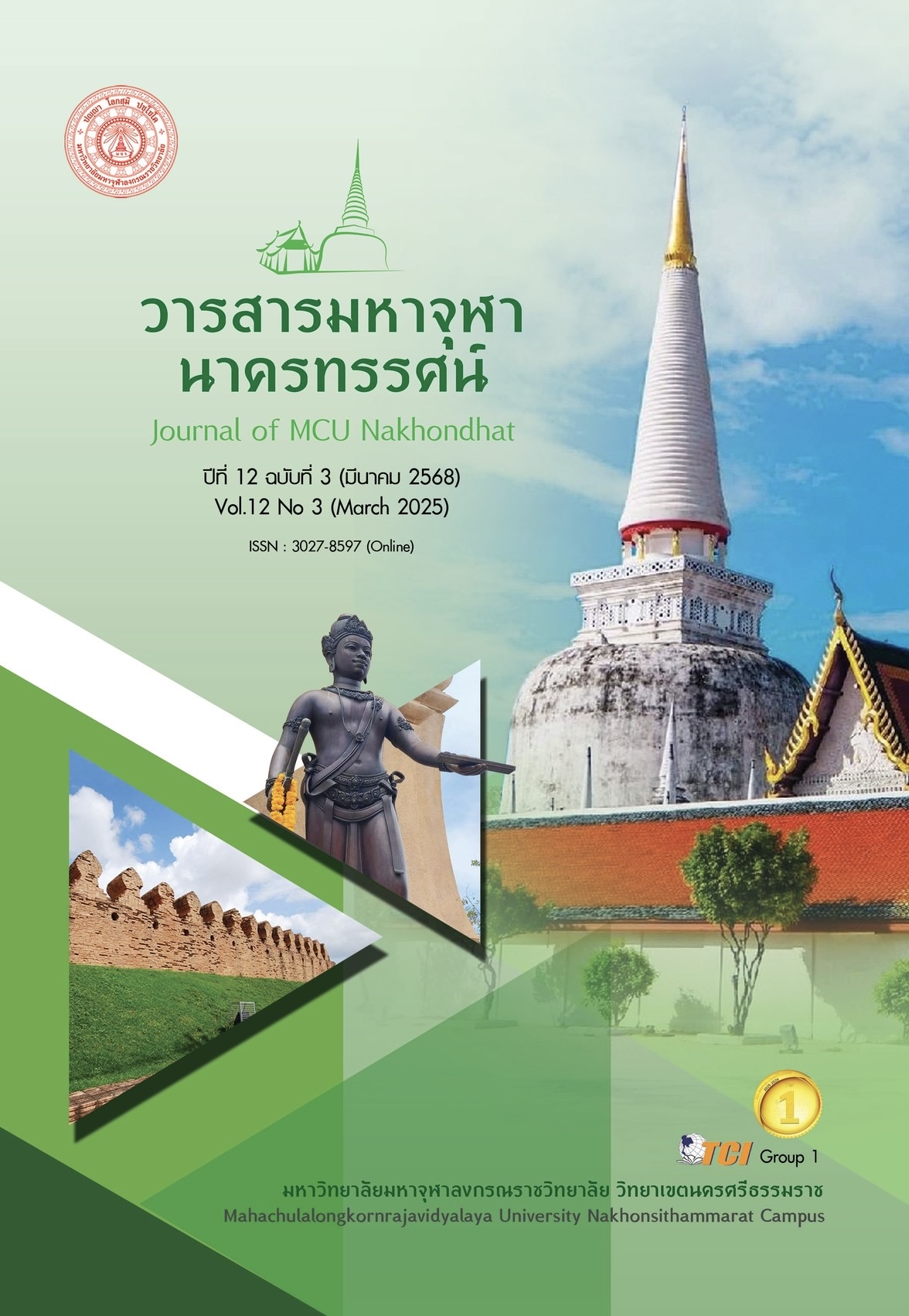THE RESULTS OF A DEVELOPMENT OF LOCAL GEOHAZARD CURRICULUM TO ENHANCE SPATIAL THINKING SKILLS FOR HIGH SCHOOL STUDENTS
Main Article Content
Abstract
This research aimed to 1) Investigating the needs for developing a local geohazard curriculum, the content of local geohazard related learning, and learning management strategies to enhance spatial thinking skills for high school students, and 2) To create and examine the quality of a local geohazard curriculum to enhance spatial thinking skills for high school students. The research was conducted through research and development processes, which devided into 2 steps: A sample group of 39 students in Grade 10 of Wangthong Pittayakhom school, who were randomly selected through a classroom as a random unit. The tools used in the research include interviews, the local geohazard curriculum, course materials, and an interview on the feasibility of the curriculum. Statistical methods such as mean and standard deviation were used for analysis. The results show that: 1) The required for developing the curriculum in order to determine the content include: the history of local geohazard, local geohazard management, risk reduction from local geohazard, local geohazard risk assessment, evacuation, and adaptation to living with local geohazard. 2) In order to enhance spatial thinking skills, Geographic processes and geographic tools in surveying and observing disaster-prone areas should be employed. Asking questions is used to allow learners to analyze and comprehend the occurrence of geohazards in relation to the areas, as well as to find out strategies for disaster risk reduction. 3) The curriculum consists has 8 components: principles and rationale, curriculum objectives, curriculum content, course description, course structure, learning activity management guidelines, guidelines for using media and learning resources, The evaluation results of the curriculum's appropriateness are at very high level
( = 4.48, S.D. = 0.56) and it’s feasible for practical implementation.
Article Details

This work is licensed under a Creative Commons Attribution-NonCommercial-NoDerivatives 4.0 International License.
References
กรมป้องกันและบรรเทาสาธารณภัย. (2560). คู่มือประชาชนในการเตรียมตัวให้รอดปลอดภัยพิบัติ. (พิมพ์ครั้งที่ 6). กรุงเทพมหานคร: เวิร์ค พริ้นติ้ง จำกัด.
จักรกฤษณ์ จันทะคุณ. (2558). ภัยพิบัติศึกษา: แนวทางการจัดกิจกรรมการเรียนรู้เพื่อเตรียมความพร้อมรับมือภัยพิบัติ. วารสารศึกษาศาสตร์มหาวิทยาลัยนเรศวร, 17(4), 188-201.
จักรกฤษณ์ จันทะคุณ. (2564). การพัฒนาหลักสูตรเสริมสร้างทักษะเอาชีวิตรอดจากภัยพิบัติธรรมชาติ: กรณีศึกษาถ้ำหลวง จังหวัดเชียงราย ด้วยกระบวนการโค้ช. วารสารศึกษาศาสตร์ มหาวิทยาลัยนเรศวร, 23(2), 375-390.
บุญเลี้ยง ทุมทอง. (2554). การพัฒนาหลักสูตร. (พิมพ์ครั้งที่ 3). กรุงเทพมหานคร: สำนักพิมพ์แห่งจุฬาลงกรณ์มหาวิทยาลัย.
พิมพันธ์ เดชะคุปต์ และพเยาว์ ยินดีสุข. (2560). ทักษะ 7C ของครู 4.0. กรุงเทพมหานคร: โรงพิมพ์แห่งจุฬาลงกรณ์มหาวิทยาลัย.
ไพฑูรย์ ฤทธิ์กระโทก. (2554). การพัฒนาหลักสูตรลูกเสือสามัญ ตามแนวคิดการผจญภัยศึกษาของลอร์ดบาเด็นพาวเวลล์ เพื่อเสริมสร้างความรู้ความเข้าใจและทักษะการอยู่รอดของนักเรียนประถมศึกษา. ใน วิทยานิพนธ์ครุศาสตรดุษฎีบัณฑิต สาขาการสอนภาษาไทย. จุฬาลงกรณ์มหาวิทยาลัย.
เลเกีย เขียวดี. (2555). การพัฒนารายวิชาภูมิศาสตร์กายภาพสำหรับครูเพื่อส่งเสริมทักษะการคิดเชิงพื้นที่ สำหรับนักศึกษาโปรแกรมวิชาสังคมศึกษา คณะครุศาสตร์ มหาวิทยาลัยราชภัฏกำแพงเพชร. ใน รายงานการวิจัย. มหาวิทยาลัยเชียงใหม่.
สงัด อุทรานันท์. (2532). พื้นฐานและหลักการพัฒนาหลักสูตร. กรุงเทพมหานคร: จุฬาลงกรณ์มหาวิทยาลัย.
สำนักวิชาการและมาตรฐานการศึกษา. (2560). ตัวชี้วัดและสาระการเรียนรู้แกนกลางสาระภูมิศาสตร์ (ฉบับปรับปรุง พ.ศ. 2560) กลุ่มสาระการเรียนรู้สังคมศึกษา ศาสนา และวัฒนธรรม ตามหลักสูตรแกนกลางการศึกษา
ขั้นพื้นฐาน พุทธศักราช 2551 และแนวการจัดกิจกรรมการเรียนรู้. กรุงเทพมหานคร: โรงพิมพ์ชุมนุมสหกรณ์การเกษตรแห่งประเทศไทย จํากัด.
สุดาพร ปัญญาพฤกษ์ และคณะ. (2565). การพัฒนาหลักสูตรภัยพิบัติแผ่นดินไหวสำหรับเยาวชนและประชาชน จังหวัดเชียงราย. วารสารราชพฤกษ์, 20(1), 128-141.
Bersea, K. B. et al. (2011). Beyond geo-spatial technologies: promoting spatial thinking through local disaster risk management planning. Procedia Social and Behavioral Sciences, 21(2011), 73-82, https://doi.org/10.1016/j.sbspro.2011.07.037
Bodzin, A. M. (2011). The Implementation of a Geospatial Information Technology (GIT)-Supported Land Use Change Curriculum With Urban Middle School Learners to Promote Spatial Thinking. Journal of Research in Science Teaching, 48(3), 281-300.
Koc, T. & Topu, F. B. (2021). Using three-dimensional geospatial technology in primary school: students’ achievements, spatial thinking skills, cognitive load levels, experiences and teachers. opinions Education and Information Technologies, 27(4), 4925-4954.
Lee, J. & Bednarz, R. (2009). Effect of GIS Learning on Spatial Thinking. Journal of Geography in Higher Education, 33(2), 183-198, http://dx.doi.org/10.1080/03098260802276714
Mohadjer, S. et al. (2008). Earthquake Emergency Education in Dushanbe, Tajikistan. Journal of Geoscience Education, 58(2), 86-94.
Ridha, S. et al. (2019). Spatial Thinking and Decision-Making Abilities to Learn About Disaster Preparedness. IOP Conference Series: Earth and Environmental Science, 630(12), 1-9.
Rusman & Rohman, A. (2017). Development of Training Curriculum in Improving Community-Based Geological Hazard Mitigation Competency. MIMBAR, 33(2), 416-425.
Taba, H. (1962). Curriculum Development: Theory and Practice. New York: Harcourt, Brace And World Nic.
Wahyuningtyas, N. et al. (2021). Forming spatial thinking skills of social studies students in phenomenon analysis geosphere through the Geographic Information System (GIS). Series: Earth and Environmental Science, 747(2021), 012005. http://dx.doi.org/10.1088/1755-1315/747/1/012005

